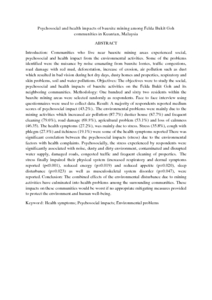Citation
Ahmadian, Maryam and Carmack, Suzie and Abu Samah, Asnarulkhadi and Kreps, Gary and Saidu, Mohammed Bashir
(2016)
Psychosocial predictors of breast self-examination among female students in Malaysia: a study to assess the roles of body image, self-efficacy and perceived barriers.
Asian Pacific Journal of Cancer Prevention, 17 (3).
pp. 1277-1284.
ISSN 1513-7368; ESSN: 2476-762X
Abstract
Background: Early detection is a critical part of reducing the burden of breast cancer and breast self-examination (BSE) has been found to be an especially important early detection strategy in low and middle income countries such as Malaysia. Although reports indicate that Malaysian women report an increase in BSE activity in recent years, additional research is needed to explore factors that may help to increase this behavior among Southeastern Asian women. Objective: This study is the first of its kind to explore how the predicting variables of self-efficacy, perceived barriers, and body image factors correlate with self-reports of past BSE, and intention to conduct future breast self-exams among female students in Malaysia. Materials and methods: Through the analysis of data collected from a prior study of female students from nine Malaysian universities (n=842), this study found that self-efficacy, perceived barriers and specific body image sub-constructs (MBSRQ-Appearance Scales) were correlated with, and at times predicted, both the likelihood of past BSE and the intention to conduct breast self-exams in the future. Results: Self-efficacy (SE) positively predicted the likelihood of past self-exam behavior, and intention to conduct future breast self-exams. Perceived barriers (BR) negatively predicted past behavior and future intention of breast self-exams. The body image sub-constructs of appearance evaluation (AE) and overweight preoccupation (OWP) predicted the likelihood of past behavior but did not predict intention for future behavior. Appearance orientation (AO) had a somewhat opposite effect: AO did not correlate with or predict past behavior but did correlate with intention to conduct breast self-exams in the future. The body image sub-constructs of body area satisfaction (BASS) and self-classified weight (SCW) showed no correlation with the subjects' past breast self-exam behavior nor with their intention to conduct breast self-exams in the future. Conclusions: Findings from this study indicate that both self-efficacy and perceived barriers to BSE are significant psychosocial factors that influence BSE behavior. These results suggest that health promotion interventions that help enhance self-efficacy and reduce perceived barriers have the potential to increase the intentions of Malaysian women to perform breast self-exams, which can promote early detection of breast cancers. Future research should evaluate targeted communication interventions for addressing self-efficacy and perceived barriers to breast self-exams with at-risk Malaysian women and further explore the relationship between BSE and body image.
Download File
![[img]](http://psasir.upm.edu.my/53700/1.hassmallThumbnailVersion/Psychosocial%20and%20health%20impacts%20of%20bauxite%20mining%20among%20Felda%20Bukit%20Goh%20communities%20in%20Kuantan%2C%20Malaysia.pdf)  Preview |
|
PDF
Psychosocial and health impacts of bauxite mining among Felda Bukit Goh communities in Kuantan, Malaysia.pdf
Download (7kB)
| Preview
|
|
Additional Metadata
Actions (login required)
 |
View Item |

